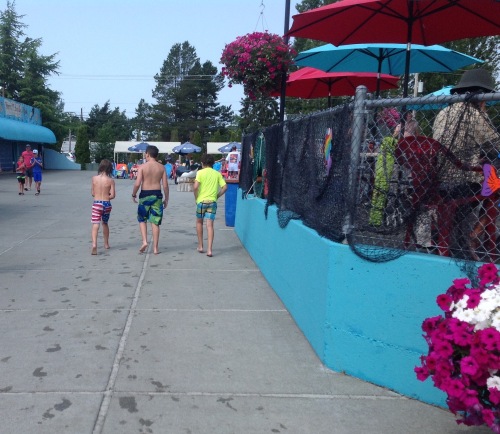
At the Waterslides, Summer 2018
My daughter and grandson have been visiting this week from the East Coast just outside Boston. I worried about whether my grandson would have enough to do while visiting, but – as you see – kids find other kids and off they go. Five hours yesterday in the blistering heat at Birch Bay Water Slides (“Where the Sun Always Shines”) —what’s not to love?
Why am I posting this photo? Just wanted to remind myself of who I write for. I can get isolated at my desk while I write; it’s refreshing to be with kids when I’m stuck for a story or when I run out of juice – it’s good to be where I can hear them laugh, or where I can listen to the stories they tell me.
Some of us write for the boy with an undercurrent of shyness, some for the kid with 60’s hair and a wild flag swim suit. Sometimes we write for the kid with a summer buzz-cut who is willing to pause for a photo for his grandmother when he’s dying to get back to the slides.



We write for the kid who is shivering. The kid laughing. We write for kids of every imaginable shape and size. Kids at summer camp who miss home. Kids for whom summer camp is only a dream. Kids having chocolate-vanilla swirl ice cream cones melting too fast to keep them from dripping all down their arms. Kids visitng libraries and signing up for summer reading programs. Kids with pals…and kids without. Kids who remind us of ourselves. Sometimes for kids whose troubles make our hearts ache. Other times for kids who make us believe in the world again.
Spend a summer day with kids and have a ball. Laugh a little with them. Listen. Think about the energy they have. We write for kids. How lucky is that?

Photo done, back to the slides….

 Dear Hannah Gadsby,
Dear Hannah Gadsby,
 For many years I have had one foot in the world of picture books and another in the world of textiles.
For many years I have had one foot in the world of picture books and another in the world of textiles.





 Answer: The black was stenciled onto 4 pieces of paper. The colors were painted on. The papers were rotated and stitched together.
Answer: The black was stenciled onto 4 pieces of paper. The colors were painted on. The papers were rotated and stitched together.





